Have you ever wondered what exactly a dough hook is and how it can revolutionize your baking experience? Well, you’re in the right place! A dough hook is a versatile attachment for a stand mixer that takes the hassle out of kneading dough. Whether you’re making bread, pizza, or any other baked goods, this handy tool will help you achieve perfect results every time.
- A dough hook is an attachment for a stand mixer used to knead dough, making the process more efficient and effortless.
- It helps create smooth and elastic dough, making it easier to work with and shape.
- Using a dough hook saves time and effort, making it a valuable tool for home bakers.
- By locking the bowl into the mixer and letting the dough hook work its magic, you can achieve consistent and professional-quality results.
- Dough hooks are available in various types, so you can choose the right one for your specific baking needs.
Now that you have a better understanding of what a dough hook is and how it can enhance your baking endeavors, let’s dive deeper into the functionality and benefits of using this amazing attachment.
Understanding the Basics: How Does a Dough Hook Work?
Let’s dive into the intricacies of a dough hook and discover how it simplifies the laborious task of kneading dough. A dough hook is an attachment for a stand mixer that takes the elbow grease out of kneading and makes the process more efficient. If you have ever tried kneading dough by hand, you know it can be a tiring and time-consuming process. With a dough hook, the mixer does the hard work for you, allowing you to achieve smooth and elastic dough with minimal effort.
To use a dough hook, simply place all the wet and dry ingredients in the bowl of the stand mixer and mix them together until they come together. Once the ingredients are combined, lock the bowl into the mixer and let it work on low speed for a specified amount of time, usually around eight minutes. The dough hook kneads the dough by stretching and folding it, developing the gluten and creating a smooth and elastic texture.
The benefits of using a dough hook are manifold. First and foremost, it saves you time and energy. No more kneading by hand for long periods. Additionally, a dough hook ensures more consistent results by providing a thorough and even knead every time. It also eliminates the risk of over-kneading, which can lead to tough and dense bread. With a dough hook, you can achieve professional-quality dough without breaking a sweat.
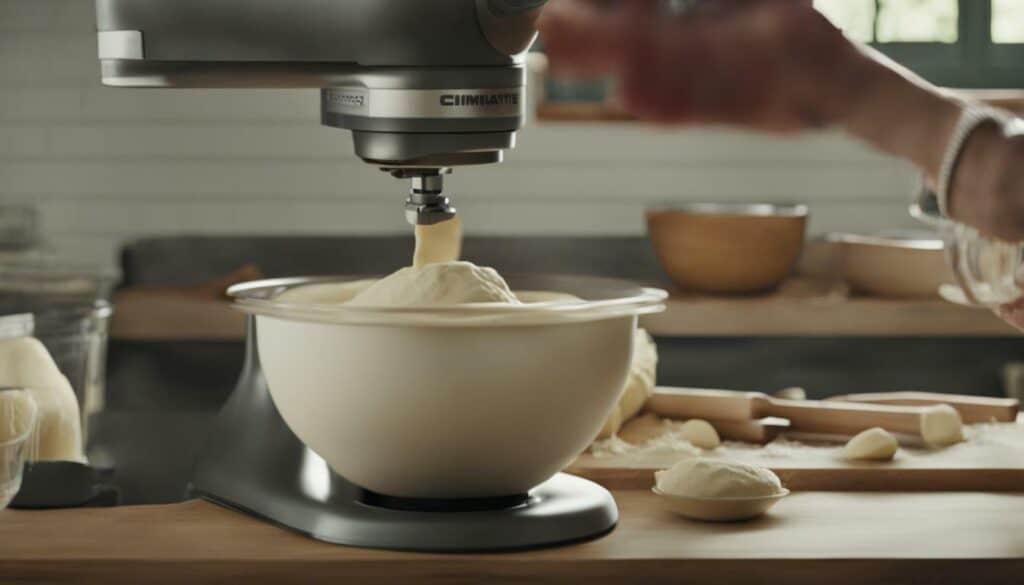
So, if you are a home baker looking to simplify your bread-making process or a professional baker in need of a reliable tool, a dough hook is a must-have. It will save you time, effort, and guarantee consistent and excellent results. Take advantage of this versatile attachment and enjoy the pleasure of baking without the laborious task of kneading dough by hand.
Exploring Different Types of Dough Hooks
From spiral dough hooks to C-shaped ones, there is a range of options to suit different baking needs. Each type of dough hook offers unique advantages and is designed to handle specific dough consistencies. Understanding the different types of dough hooks will help you choose the right attachment for your baking projects.
1. Spiral Dough Hook: This type of dough hook features a spiral design that mimics the motions of hand kneading. It works well for heavy doughs with low hydration, such as bagel or pizza dough. The spiral shape helps to thoroughly knead the dough, ensuring even gluten development.
2. C-Shaped Dough Hook: The C-shaped dough hook is commonly found in stand mixers and is suitable for a wide range of doughs. Its curved design allows for effective mixing and kneading of wetter, softer doughs like brioche or sandwich bread. The C-shape prevents the dough from climbing up the hook, ensuring a consistent and thorough kneading process.
3. Double Dough Hook: As the name suggests, the double dough hook consists of two hooks attached to a central arm. This design is ideal for handling large batches of dough, making it a popular choice in commercial bakeries. The double dough hook provides efficient mixing and kneading, ensuring uniform dough development.
Additional Dough Hook Attachments
In addition to the main types mentioned above, there are other specialized dough hook attachments available:
- Flex Edge Beater: Although not a traditional dough hook, the flex edge beater is designed to scrape the sides of the bowl while mixing, making it suitable for lighter doughs.
- Spiral Burnished Dough Hook: This type of dough hook features a burnished coating that provides a non-stick surface, preventing the dough from sticking and ensuring easy cleanup.
- Coated Dough Hook: Coated with a food-grade nylon or silicone material, these dough hooks are gentle on non-stick surfaces and minimize scratching or damage to the mixer bowl.
| Type of Dough Hook | Recommended Dough Consistencies |
|---|---|
| Spiral Dough Hook | Heavy, low-hydration doughs |
| C-Shaped Dough Hook | Wetter, softer doughs |
| Double Dough Hook | Large batches of dough |
When selecting a dough hook, consider the types of dough you frequently work with and the desired results. Experiment with different attachments to find the one that suits your baking style and preferences best. With the right dough hook, you can achieve consistent and professional-quality dough every time.
The Dough Hook vs Hand Kneading: Which is Better?
Is using a dough hook a superior method compared to the traditional, time-honored technique of hand kneading? This is a question that many bakers ponder when faced with the task of making bread or other yeasted goods. Let’s take a closer look at the pros and cons of both methods to determine which one reigns supreme.
Hand kneading has been a staple of bread making for centuries. The process involves using your hands to work the dough, gradually incorporating the ingredients and developing the gluten. This hands-on approach allows you to have complete control over the texture and consistency of the dough. It also allows you to connect with the dough on a deeper level, becoming one with the baking process. However, hand kneading can be time-consuming and physically demanding, especially when dealing with large batches or dense doughs.
On the other hand, using a dough hook attachment on a stand mixer offers convenience and efficiency. The dough hook does the hard work for you, kneading the dough thoroughly and evenly. This is especially beneficial when dealing with sticky or tough doughs that can be difficult to knead by hand. Additionally, using a dough hook saves you time and energy, allowing you to multitask or attend to other aspects of your baking while the machine does its job. However, it’s important to note that using a dough hook may not provide the same tactile experience and control as hand kneading.
Ultimately, the choice between using a dough hook or hand kneading comes down to personal preference and the specific needs of the recipe. Some bakers swear by the therapeutic benefits of hand kneading and enjoy the artistry of the process. Others prefer the convenience and consistency that a dough hook provides. Whichever method you choose, the key is to achieve a smooth and elastic dough that is easy to work with and yields delicious results.
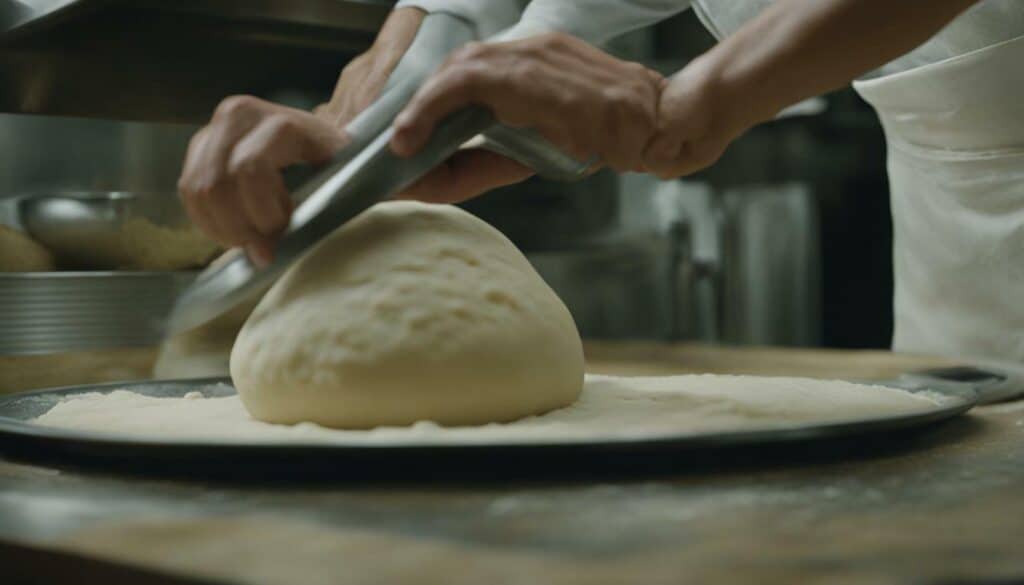
| Hand Kneading | Dough Hook |
|---|---|
| Time-consuming | Time-saving |
| Physically demanding | Effortless |
| Sensitive to dough consistency | Uniform kneading |
| Artistic and tactile experience | Convenient and consistent |
In summary, there is no definitive answer to the question of whether a dough hook is better than hand kneading. It ultimately depends on your personal preferences and the specific needs of your baking. So, why not experiment and try both methods to discover which one suits you best? The goal is to create a smooth and elastic dough that brings joy and satisfaction to your baking endeavors.
Mastering the Art: Tips for Using a Dough Hook
To make the most out of your dough hook, follow these expert tips for optimal dough consistency and texture. A dough hook is a versatile attachment that can save you time and effort in the kitchen. Here are some valuable tips to enhance your baking experience:
- Choose the right speed: When using a dough hook, start at a low speed to incorporate the ingredients and prevent them from splattering. Gradually increase the speed to develop gluten in the dough. Most recipes recommend using a medium-low speed, but it’s essential to follow the specific instructions provided.
- Add flour gradually: To achieve the perfect dough consistency, add flour gradually, one cup at a time. This method allows you to control the dough’s texture, preventing it from becoming too dry or sticky. Keep in mind that different flours absorb moisture differently, so adjust the amount based on the recipe’s requirements and the desired outcome.
- Monitor dough temperature: Pay attention to the dough’s temperature during the mixing process. Overheating can adversely affect the yeast’s performance and result in dense or misshapen bread. To maintain an ideal temperature, especially in warmer climates, consider using chilled ingredients or placing the mixing bowl in a cool environment.
If you’re new to using a dough hook, don’t be discouraged if your first few attempts don’t turn out perfectly. Like any skill, practice makes perfect. Experiment with different recipes, techniques, and ingredients to find what works best for you. Remember, the dough hook is designed to make your baking experience easier and more enjoyable.
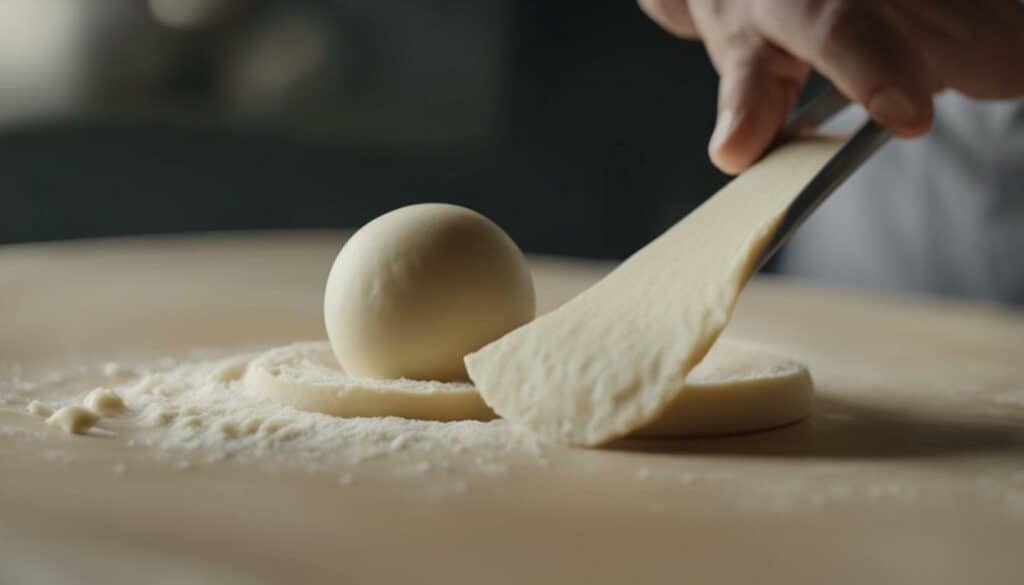
A clean dough hook ensures optimal performance and longevity. After each use, remove any dough residue by gently tapping it against the side of the mixing bowl or using a spatula. To thoroughly clean the dough hook, detach it from the stand mixer and wash it with warm, soapy water. Dry it thoroughly before reattaching or storing it. Regular maintenance will help you maintain the quality of your dough hook for years to come.
| Bonus Tip: | Time-Saving Technique |
|---|---|
| “A pro tip for saving time in the kitchen is to let the dough hook do all the hard work for you. While the dough is kneading, take the opportunity to prepare other ingredients or clean up the workstation. Maximize your efficiency and enjoy a stress-free baking experience!” | – Baking Expert |
Troubleshooting Common Dough Hook Issues
Encountering issues with your dough hook? Don’t worry – we’ve got you covered with troubleshooting suggestions. The dough hook is a valuable tool in bread baking, but sometimes things can go awry. Here are some common problems you might encounter and how to overcome them.
Dough Sticking to the Hook
If your dough is sticking to the dough hook instead of coming together into a smooth ball, it could be too wet. Try adding a little more flour, a tablespoon at a time, until the dough begins to pull away from the sides of the bowl and forms a cohesive mass. On the other hand, if your dough is too dry and crumbly, try adding a tablespoon of water or other liquid to help it come together.
Noisy Operation
Is your dough hook making an unusual noise while it’s kneading? This may be due to the bowl or the hook not being properly secured. Make sure the bowl is locked firmly into place and the hook is attached securely to the mixer. If the noise persists, check for any loose parts and tighten them as needed. If the problem still persists, it may be worth contacting the manufacturer for further assistance.
Uneven Mixing
If you find that your dough isn’t mixing evenly, with some parts overworked and others underdeveloped, it could be a problem with the dough hook speed or the amount of dough in the bowl. Adjust the speed setting on your mixer – lower speed for smaller batches and higher speed for larger ones. Additionally, make sure not to overload the mixer with too much dough as it can strain the motor and result in uneven mixing.
Table: Troubleshooting Tips for Dough Hook Issues
| Issue | Troubleshooting Tip |
|---|---|
| Dough sticking to the hook | Adjust moisture levels by adding more flour or liquid as needed |
| Noisy operation | Ensure the bowl and hook are securely attached, tighten any loose parts |
| Uneven mixing | Adjust speed setting and avoid overloading the mixer |
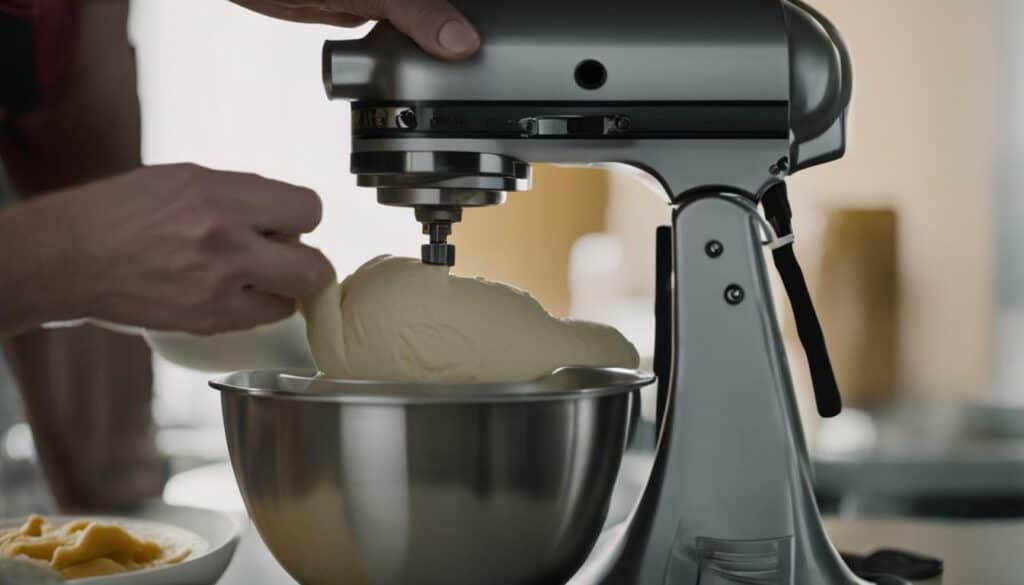
Discover the factors to consider when choosing a dough hook that aligns perfectly with your baking preferences. As a home baker, finding the right dough hook attachment for your stand mixer can make a world of difference in your dough-making process. With a wide variety of options available in the market, it’s important to understand the key considerations to ensure you make the perfect choice.
When selecting a dough hook, the first factor to consider is the size and capacity of your stand mixer. Different mixers have varying bowl sizes, and it’s crucial to choose a dough hook that fits your specific mixer. A dough hook that is too small or too large for your mixer can affect the kneading process, resulting in uneven mixing or poor dough development.
Another important consideration is the type of dough you typically work with. Different dough hooks are designed for specific types of dough, such as bread, pizza, or pastry. For example, a spiral dough hook is ideal for heavy-duty bread dough, while a C-shaped dough hook is better suited for lighter doughs like pastry. Understanding the type of dough you work with will help you choose a dough hook that will provide optimal performance.

Lastly, don’t forget to take into account the material and build quality of the dough hook. Stainless steel dough hooks are durable and resistant to rust, ensuring longevity and ease of maintenance. Additionally, consider ergonomics and ease of use, as a comfortable handle and secure attachment mechanism can enhance your baking experience.
By considering factors such as mixer compatibility, dough type, material, and build quality, you can select the perfect dough hook that will help you achieve excellent baking results. Experimenting with different dough hooks can also be a fun and rewarding way to discover which attachment works best for your unique baking style. So, go ahead, choose the dough hook that matches your needs, and enjoy effortless and delicious homemade bread, pizza, and more!
The Beauty of Smooth and Elastic Dough
Using a dough hook can result in a beautifully elastic dough, making it easier to handle and shape. This attachment for a stand mixer takes the hard work out of kneading, allowing you to achieve professional-quality dough without the effort. The dough hook’s design and motion mimic the action of hand kneading, but with greater efficiency and consistency.
When the dough hook is engaged, it rotates and stretches the gluten strands in the dough, creating a structure that is both stretchy and resilient. This elasticity is essential for achieving the perfect rise and texture in baked goods. The smooth and uniform kneading action of a dough hook helps to evenly distribute the ingredients and develop the gluten, resulting in a more consistent and well-textured dough.
Whether you are making bread, pizza dough, or any other yeasted recipe, using a dough hook can save you time and effort. Instead of spending precious minutes kneading by hand, you can let the dough hook do the work for you while you attend to other tasks in the kitchen. This versatility is especially valuable for home bakers who want to streamline their baking process and achieve professional results.
| Dough Hook Benefits |
|---|
| Efficient and consistent kneading |
| Time-saving |
| Creates a smooth and elastic texture |
| Evenly distributes ingredients |
| Perfect for home bakers |

With a dough hook, you can achieve the ideal dough consistency every time. It simplifies the process of kneading, allowing you to enjoy the therapeutic art of baking without the physical strain. Whether you are a beginner or an experienced baker, a dough hook is an essential tool that can elevate your baking skills and bring your homemade bread and pastries to the next level.
The Secrets of Working with a Dough Hook
Unlock the secrets of mastering the art of dough-making with the help of a trusty dough hook. This versatile attachment for your stand mixer can take the effort out of kneading and help you achieve perfect dough consistency every time. Whether you’re an experienced baker or just starting out, here are some tips to maximize your dough hook’s potential:- Start with the right speed: When using a dough hook, it’s important to start at a low speed to allow the hook to properly mix and knead the dough. This will help prevent the dough from splattering out of the bowl.
- Use the right amount of flour: Adding too much flour can result in a dry and tough dough, while adding too little can make it sticky and unmanageable. It’s important to find the right balance for your specific recipe, adding flour gradually until the dough reaches a soft and elastic consistency.
- Monitor the dough temperature: Overheating the dough can affect the yeast’s activity and result in poor rise and texture. Keep an eye on the dough’s temperature, especially if you’re using a high-speed setting, and adjust as needed to maintain an ideal dough temperature.
Extra tips for the perfect dough:
- Let the dough rest: After kneading with the dough hook, it’s beneficial to let the dough rest for a few minutes. This allows the gluten to relax, making it easier to shape and work with.
- Add ingredients gradually: Instead of dumping all the ingredients into the mixer at once, add them gradually. This helps ensure even distribution and thorough mixing.
- Clean the dough hook properly: After each use, make sure to clean the dough hook thoroughly to remove any residual dough. This will prevent any unwanted flavors or textures from transferring to future batches.
With these secrets in mind, you’ll be well on your way to creating delicious homemade bread, pizza dough, and more. Embrace the convenience and efficiency of a dough hook, and watch your baking skills soar!
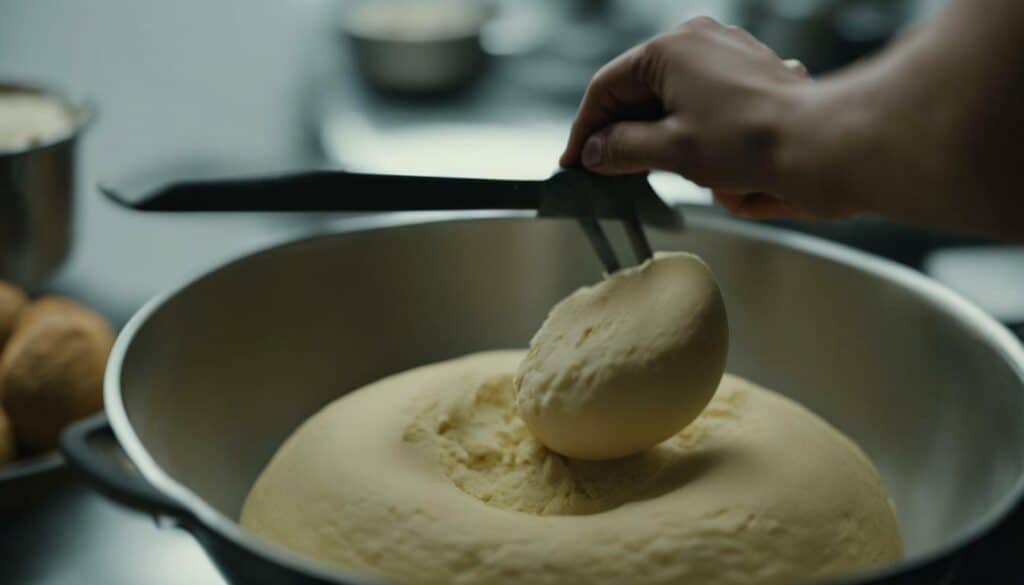
Whether you’re an aspiring baker or a seasoned pro, a dough hook is a game-changing tool for your baking repertoire. This handy attachment for your stand mixer takes the elbow grease out of kneading and makes the process more efficient. With a dough hook, you can effortlessly mix and knead dough for bread, pizza, and other baked goods, saving you time and effort in the kitchen.
The beauty of a dough hook lies in its ability to create a smooth and elastic dough, which is essential for achieving delicious and perfectly textured baked goods. By using a dough hook, you can ensure that your dough is thoroughly mixed and kneaded, resulting in a consistent and even rise during baking. This means no more unevenly baked loaves or dense, heavy breads.
To use a dough hook, simply attach it to your stand mixer and place all the wet and dry ingredients in the mixer’s bowl. Turn it on and let the dough hook work its magic on low speed for the specified amount of time. As the dough hook kneads the dough, it forms a cohesive mass, incorporating the ingredients and developing the gluten. The end result is a dough that is smooth, elastic, and ready to be shaped into your desired baked goods.
| Benefits of Using a Dough Hook: |
|---|
| Effortlessly mixes and kneads dough |
| Saves time and effort in the kitchen |
| Creates a smooth and elastic dough for better baking results |
| Consistently produces evenly textured bread and other baked goods |
So, whether you’re a home baker looking to level up your dough-making game or a professional baker seeking efficiency in the kitchen, a dough hook is a must-have tool. Embrace the versatility and convenience it offers, and say goodbye to the tedious task of hand kneading. Let your dough hook do the hard work for you, while you focus on creating delicious and beautifully baked treats.
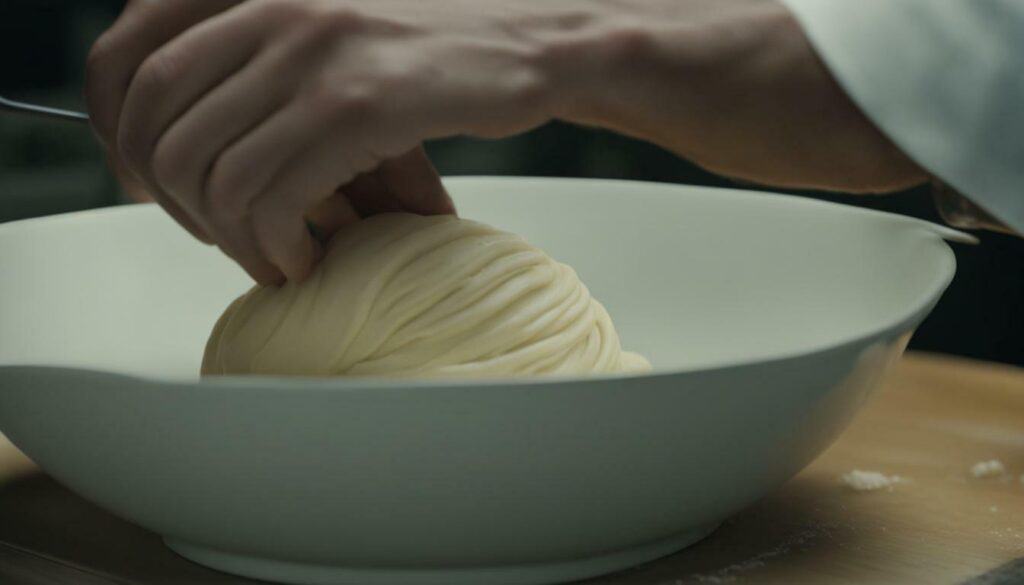
Now that you are well-versed in the world of dough hooks, you can confidently step into the kitchen and elevate your baking skills. The dough hook is a versatile tool that takes the hard work out of kneading dough, allowing you to achieve professional-quality results with ease.
By using a dough hook attachment on your stand mixer, you can save time and energy while still achieving a smooth and elastic dough. Whether you’re making bread, pizza, or any other yeasted goods, the dough hook will become your new best friend in the kitchen.
Remember, when using a dough hook, it’s important to choose the right type for your specific baking needs. Different dough hooks are designed for different purposes, so do your research and select the one that will work best for you.
Once you have your dough hook, follow the tips and techniques we’ve discussed throughout this article to ensure success. From troubleshooting common issues to mastering the art of working with a dough hook, you’ll soon become a pro at using this essential tool.
So, don’t be intimidated by dough anymore. Embrace the convenience and efficiency of a dough hook and enjoy the satisfaction of creating delicious homemade baked goods. Happy baking!
FAQ
Q: What is a dough hook?
A: A dough hook is an attachment for a stand mixer that is used to knead dough for bread, pizza, and other baked goods. It takes the elbow grease out of kneading and makes the process more efficient.
Q: How does a dough hook work?
A: To use a dough hook, you simply put all the wet and dry ingredients in the bowl of the stand mixer and mix them together until they come together. Then, you lock the bowl into the mixer and let it work on low speed for a specified amount of time, usually around eight minutes. The dough hook helps to create a smooth and elastic dough, making it easier to shape and work with.
Q: What are the benefits of using a dough hook?
A: Using a dough hook attachment can save you time and effort in the kneading process. It ensures that the dough is thoroughly mixed and kneaded, resulting in a consistent texture. It also helps in developing gluten in the dough, which is essential for achieving a light and airy bread.
Q: Are there different types of dough hooks available?
A: Yes, there are various types of dough hooks available in the market. Some are designed specifically for certain mixers or models, while others are more universal. There are also different shapes and sizes of dough hooks to accommodate different dough quantities and textures.
Q: Is using a dough hook better than hand kneading?
A: Using a dough hook can be more efficient and less physically demanding compared to hand kneading. However, hand kneading can provide a tactile experience and allows for better control over the dough. The choice between the two methods depends on personal preference and the desired outcome.
Q: What are some tips for using a dough hook?
A: When using a dough hook, it is important to start with the recommended speed and mixing time as specified in the recipe. It is also helpful to scrape down the sides of the bowl occasionally to ensure all ingredients are incorporated. Additionally, adjusting the speed or adding more flour or liquid may be necessary depending on the consistency of the dough.
Q: What should I do if I encounter issues when using a dough hook?
A: Common issues when using a dough hook include the dough sticking to the sides of the bowl or the hook, or the dough not coming together properly. To troubleshoot these issues, you can adjust the speed or add more flour or liquid as needed. You can also stop the mixer and scrape down the sides of the bowl to ensure all ingredients are mixed properly.
Q: How do I choose the right dough hook?
A: When choosing a dough hook, consider the type of stand mixer you have and its compatibility with different attachments. Also, consider the size and quantity of dough you typically work with. Some dough hooks are designed for smaller batches, while others are more suitable for larger quantities.
Q: What are the benefits of using a dough hook to achieve smooth and elastic dough?
A: Using a dough hook helps to develop gluten in the dough, resulting in a smoother and more elastic texture. This makes the dough easier to work with, shape, and manipulate. It also contributes to a better rise and a more uniform crumb structure in the final baked products.
Q: What are the secrets of working with a dough hook?
A: Working with a dough hook requires attention to the mixing time, speed, and consistency of the dough. It is important to follow the instructions in the recipe and make adjustments as necessary. It can also be helpful to let the dough rest or rise for a period of time after mixing to allow the gluten to relax and the flavors to develop.
Q: Why is a dough hook considered an essential tool for home bakers?
A: A dough hook is a valuable tool for home bakers who regularly make bread or other yeasted goods. It simplifies the kneading process and ensures consistent results. Using a dough hook allows home bakers to achieve professional-quality dough without the need for extensive manual labor.
What is the Purpose of a Dough Hook?
A dough hook is a tool used in baking for kneading dough. It is typically a sturdy, metal attachment that connects to a stand mixer. What is a dough hook‘s purpose? Well, it efficiently mixes and kneads the dough, saving time and effort compared to traditional hand-kneading methods.


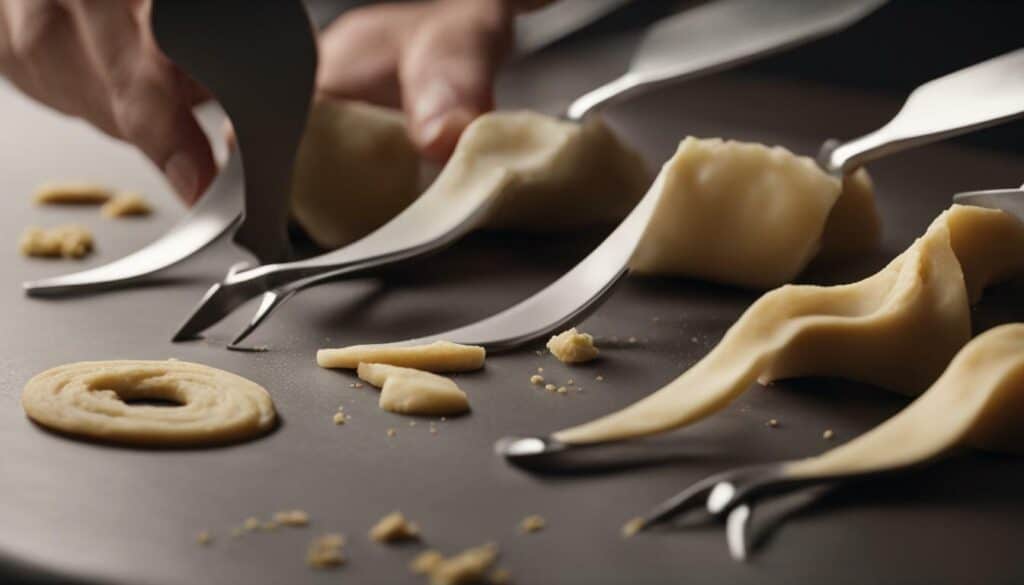



Leave a Reply